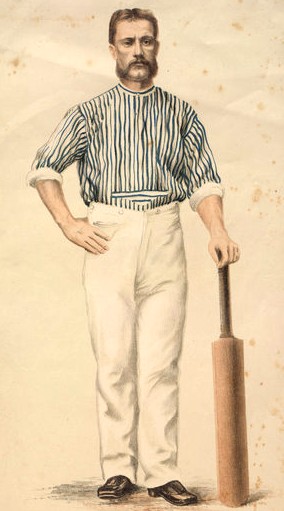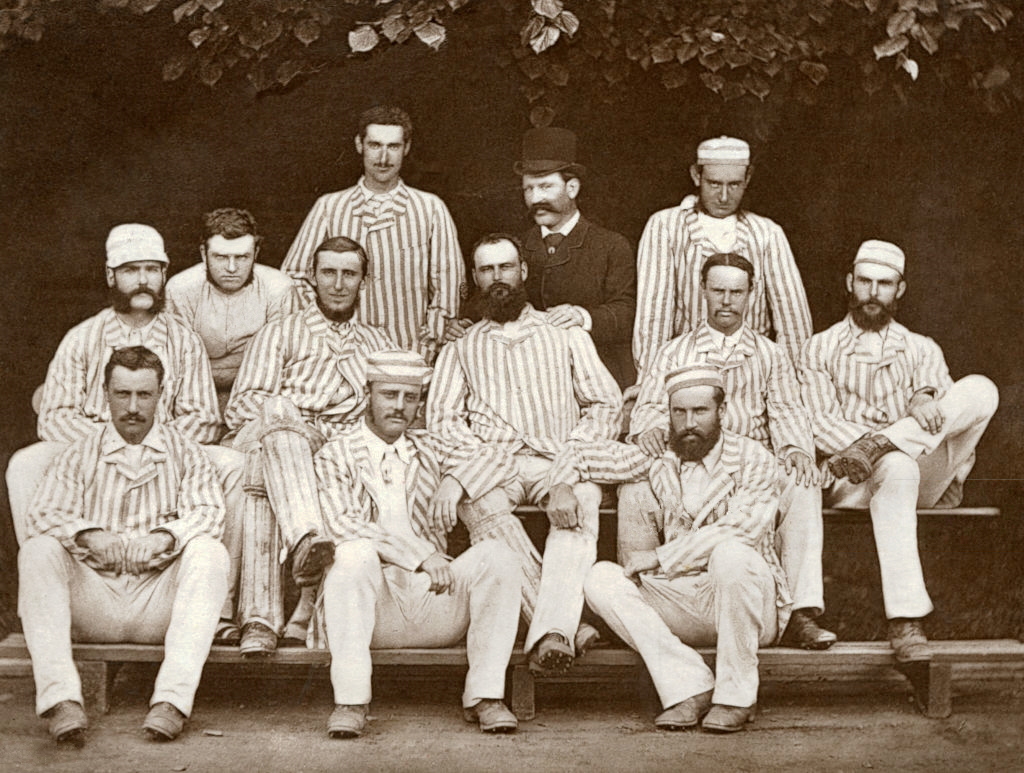|
Harry Jupp
Henry Jupp (19 November 1841 – 8 April 1889) was an English professional cricketer who was the opening batsman for Surrey County Cricket Club from 1862 to 1881. He played in the first-ever Test match, scoring England's first Test fifty. Life and career Early cricket career Jupp was born in Dorking, Surrey, and played his earliest cricket for the Wellesley House club in Twickenham. Despite not having any experience of first-class cricket, he took his place in a strong Surrey eleven that was to beat the best of the rest of England in 1864 by nine wickets.Wynne-Thomas, Peter; ''The Rigby A–Z of Cricket Records''; p. 53. With Thomas Humphrey, he formed Surrey's first strong opening partnership. Renowned for his defensive technique, Jupp was known as "Young Stonewaller" after the "Old Stonewaller" Will Mortlock, and was sometimes criticised for not punishing bad balls Grace, William Gilbert, “Forty Years of Cricket”; in ''The Sydney Mail''; 18 June 1890 but he had super ... [...More Info...] [...Related Items...] OR: [Wikipedia] [Google] [Baidu] |
Dorking
Dorking () is a market town in Surrey in South East England, about south of London. It is in Mole Valley District and the council headquarters are to the east of the centre. The High Street runs roughly east–west, parallel to the Pipp Brook and along the northern face of an outcrop of Lower Greensand. The town is surrounded on three sides by the Surrey Hills Area of Outstanding Natural Beauty and is close to Box Hill and Leith Hill. The earliest archaeological evidence of human activity is from the Mesolithic and Neolithic periods, and there are several Bronze Age bowl barrows in the local area. The town may have been the site of a staging post on Stane Street during Roman times, however the name 'Dorking' suggests an Anglo-Saxon origin for the modern settlement. A market is thought to have been held at least weekly since early medieval times and was highly regarded for the poultry traded there. The Dorking breed of domestic chicken is named after the town. The loca ... [...More Info...] [...Related Items...] OR: [Wikipedia] [Google] [Baidu] |
1866 English Cricket Season
1866 was the 80th season of cricket in England since the foundation of Marylebone Cricket Club (MCC). The highlight was the emergence of W. G. Grace as the game's leading batsman with the highest first-class score since William Ward's innings in 1820. James Southerton emerged as an outstanding bowler and the first known "century before lunch" was scored. Events * ''30–31 July'': W. G. Grace at the age of eighteen played an innings of 224 not out which was the highest first-class score since William Ward's record 278 for MCC against Norfolk in 1820. * ''21 August'': John Sewell was the first batsman to score a century before the luncheon interval when he advanced from 29 not out to 166 for Middlesex against Surrey at The Oval. Playing record (by county) Wynne-Thomas, Peter; ''The Rigby A-Z of Cricket Records''; p. 53 Leading batsmen (qualification 10 innings) Leading bowlers (qualification 800 balls) References Annual reviews * ''John Lillywhite's Cricketer’s Compan ... [...More Info...] [...Related Items...] OR: [Wikipedia] [Google] [Baidu] |
The Oval
The Oval, currently known for sponsorship reasons as the Kia Oval, is an international cricket ground in Kennington, located in the borough of Lambeth, in south London. The Oval has been the home ground of Surrey County Cricket Club since it was opened in 1845. It was the first ground in England to host international Test cricket in September 1880. The final Test match of the English season is traditionally played there. In addition to cricket, The Oval has hosted a number of other historically significant sporting events. In 1870, it staged England's first international football match, versus Scotland. It hosted the first FA Cup final in 1872, as well as those between 1874 and 1892. In 1876, it held both the England v. Wales and England v. Scotland rugby international matches and, in 1877, rugby's first varsity match. It also hosted the final of the 2017 ICC Champions Trophy. History The Oval is built on part of the former Kennington Common. Cricket matches were playe ... [...More Info...] [...Related Items...] OR: [Wikipedia] [Google] [Baidu] |
Charles Bannerman
Charles Bannerman (3 July 1851 – 20 August 1930) was an English-born Australian cricketer. A right-handed batsman, he represented Australia in three Test matches between 1877 and 1879. At the domestic level, he played for the New South Wales cricket team. Later, he became an umpire. He is most famous for facing the first ball ever bowled in Test cricket, scoring the first run in Test cricket and making the first Test century. This innings of 165 remains the highest individual share of a completed team innings in Test cricket history, despite more than 2,000 Test matches being played since that first Test. Ironically in another first, he was forced to retire hurt; when a ball broke his finger. Early life Bannerman was born in Woolwich, Kent, England to William Bannerman and his wife Margaret. Not long afterwards the family migrated to New South Wales, Australia, where he joined the Warwick Cricket Club in Sydney. At the club he was trained by William Caffyn, a former Surrey ... [...More Info...] [...Related Items...] OR: [Wikipedia] [Google] [Baidu] |
John Hodges
John Robart Hodges (11 August 1855 – 17 January 1933) was an Australian cricketer who played in the first two Test matches in 1877. Cricket career Hodges was born in Knightsbridge, London, on 11 August 1855 and is believed to have died on 17 January 1933 in Melbourne, Victoria. The exact details of his death remain unconfirmed but this date is generally accepted by the sport's historians. He is one of the least-known Australian players, so meteoric and short was his career. He had the unusual distinction of playing in a Test match (and not just any Test match, the first ever given such status) before playing for his colony. Therefore, the historic international, played at Melbourne in 1877 between Australia and England, was Hodges' first-class debut. A left-handed batsman and fast-medium, round-arm bowler, Hodges started playing cricket for the Capulets club in the Melbourne suburb of Collingwood. Following some good performances in club cricket, he soon appeared for ... [...More Info...] [...Related Items...] OR: [Wikipedia] [Google] [Baidu] |
James Lillywhite
James Lillywhite (23 February 1842 – 25 October 1929) was an English Test cricketer and an umpire. He was the first ever captain of the English cricket team in a Test match, captaining two Tests against Australia in 1876–77, losing the first, but winning the second. Lillywhite was born in Westhampnett in Sussex, the son of a brickmaker, John Lillywhite. In the 1861 census the 19 year old James' profession is given as Tile Maker. He was the nephew of William Lillywhite, and so cousin to William's sons, James Lillywhite senior, John, Fred and Harry. Lillywhite is termed "junior" in sources to differentiate between him and his cousin James senior. He became a professional cricketer, and played first-class cricket for Sussex from 1862 and 1883. He played one final first-class match in 1885. Before the pre-Ashes Test-playing tour to Australia in 1876–77, Lillywhite also joined tours to North America in 1868 in a team led by Edgar Willsher, to Australia in 1873–74 in a team ... [...More Info...] [...Related Items...] OR: [Wikipedia] [Google] [Baidu] |
Australian Cricket Team
The Australia men's national cricket team represents Australia in men's international cricket. As the joint oldest team in Test cricket history, playing in the first ever Test match in 1877, the team also plays One-Day International (ODI) and Twenty20 International (T20I) cricket, participating in both the first ODI, against England in the 1970–71 season and the first T20I, against New Zealand in the 2004–05 season, winning both games. The team draws its players from teams playing in the Australian domestic competitions – the Sheffield Shield, the Australian domestic limited-overs cricket tournament and the Big Bash League. The national team has played 845 Test matches, winning 401, losing 227, drawing 215 and tying 2. , Australia is ranked first in the ICC Test Championship on 128 rating points. Australia is the most successful team in Test cricket history, in terms of overall wins, win–loss ratio and wins percentage. Test rivalries include The Ashes (with England) ... [...More Info...] [...Related Items...] OR: [Wikipedia] [Google] [Baidu] |
Jimmy Cook
Stephen James Cook (born 31 July 1953) is a former South African association football and cricketer who played in three cricket Test matches and four One Day Internationals from 1991 to 1993. His son Stephen Cook currently plays for Gauteng and the national side, the Proteas. He played football for Wits University while studying for a teaching degree in the late seventies and featured in the 1978 Mainstay Cup Final. Cook was a prolific opening batsman both in his native South Africa and for Somerset County Cricket Club but South Africa's exclusion from Test cricket cost him a significant Test career. He played in all 19 of South Africa's 'unofficial Test matches' against rebel sides. Aged 39 and having waited two decades for an official Test cap, he edged Kapil Dev's opening ball, a late outswinger, to third slip in the First Test between South Africa and India at Durban in November 1992, to become the first debutant to be dismissed by the first ball of a Test match; Leon G ... [...More Info...] [...Related Items...] OR: [Wikipedia] [Google] [Baidu] |
Vijay Merchant
Vijay Singh Madhavji Merchant , real name Vijay Madhav Thackersey (12 October 1911 – 27 October 1987) was an Indian cricketer. A right-hand batter and occasional right-arm medium pace bowler, Merchant played first-class cricket for Bombay cricket team as well as 10 Test matches for India between 1929 and 1951. Behind his limited Test appearances, he dominated Indian domestic cricket – his batting average of 71.64 is the second highest first-class average in history, behind only that of Don Bradman. He is regarded as the founder of the Bombay School of Batsmanship, that placed more importance on right technique, steely temperament, and conservative approach rather than free flow of the bat, a tradition broken and remoulded only after the arrival of Sachin Tendulkar. His international career included two tours of England upon which he scored over 800 runs. English cricketer C. B. Fry exclaimed "Let us paint him white and take him with us to Australia as an opener." His br ... [...More Info...] [...Related Items...] OR: [Wikipedia] [Google] [Baidu] |
Cecil Wood (English Cricketer)
Cecil John Burditt Wood (21 November 1875 – 5 June 1960) was a first-class cricketer who played for Leicestershire County Cricket Club and London County Cricket Club. He is one of just six players in the first-class history to carry his bat twice in the same match. Making his debut in 1896, he scored 23,879 runs as an opening batsman at an average of 31.05, made in 456 first-class matches. His best score was 225. He took 172 wickets with his right arm slow bowling at 39.43 and took 180 catches in the field. He carried his bat through both innings against Yorkshire County Cricket Club at Bradford in 1911, and completed the feat 17 times in all. He hit 1,000 runs in a season 13 times, going on to 2,000 runs in 1901. A coal merchant by trade, he also captained Leicestershire in a career which ultimately spanned to 1923. He was the Leicestershire Secretary in 1940 and 1941. He was also a notable football player, playing for Leicester Fosse Leicester City Football Club i ... [...More Info...] [...Related Items...] OR: [Wikipedia] [Google] [Baidu] |
Sep Kinneir
Septimus Paul Kinneir (13 May 1871 – 16 October 1928) was an English cricketer who played in one Test match in 1911 against Australia in Sydney. The tour had come as a reward for his most prolific season with the bat, when he scored 1,629 runs in 20 matches, including a career best 268 not out, at an average of 49.36. He was named one of Wisden's cricketers of the year in 1912. A left-handed batsman and occasional right arm bowler, Kinneir made his debut for Warwickshire in 1898 and played for the team until 1914.Septimus Kinneir Cricinfo
ESPN cricinfo (formerly known as Cricinfo or CricInfo) is a sports news website exclusively for the game of cricket. The site features news, articles, l ...
[...More Info...] [...Related Items...] OR: [Wikipedia] [Google] [Baidu] |
Carry The Bat
In cricket, the term carry the bat (or carry one's bat) refers to an Batting order (cricket)#Opening batsmen, opening batsman (no. 1 and 2) who is not dismissal (cricket), dismissed ("not out") when the team Innings#Cricket, innings is closed. The term is mainly used when the innings closes after all 10 Wicket#Dismissing a batsman, wickets have fallen; that is, the other 10 players in the team have all been dismissed ("out"). It may also be used in situations where one or more of these players Substitute (cricket), retire out or are unable to bat through injury or illness, and the remaining players are all dismissed normally. It is not used, however, in any other situation where the innings closes before all 10 wickets have fallen, such as when it is Declaration and forfeiture, declared closed, or when the team successfully chases a set run target to win the match. Origin of the phrase The term "carrying one's bat" dates back to the very early days of cricket. Initially it refer ... [...More Info...] [...Related Items...] OR: [Wikipedia] [Google] [Baidu] |


